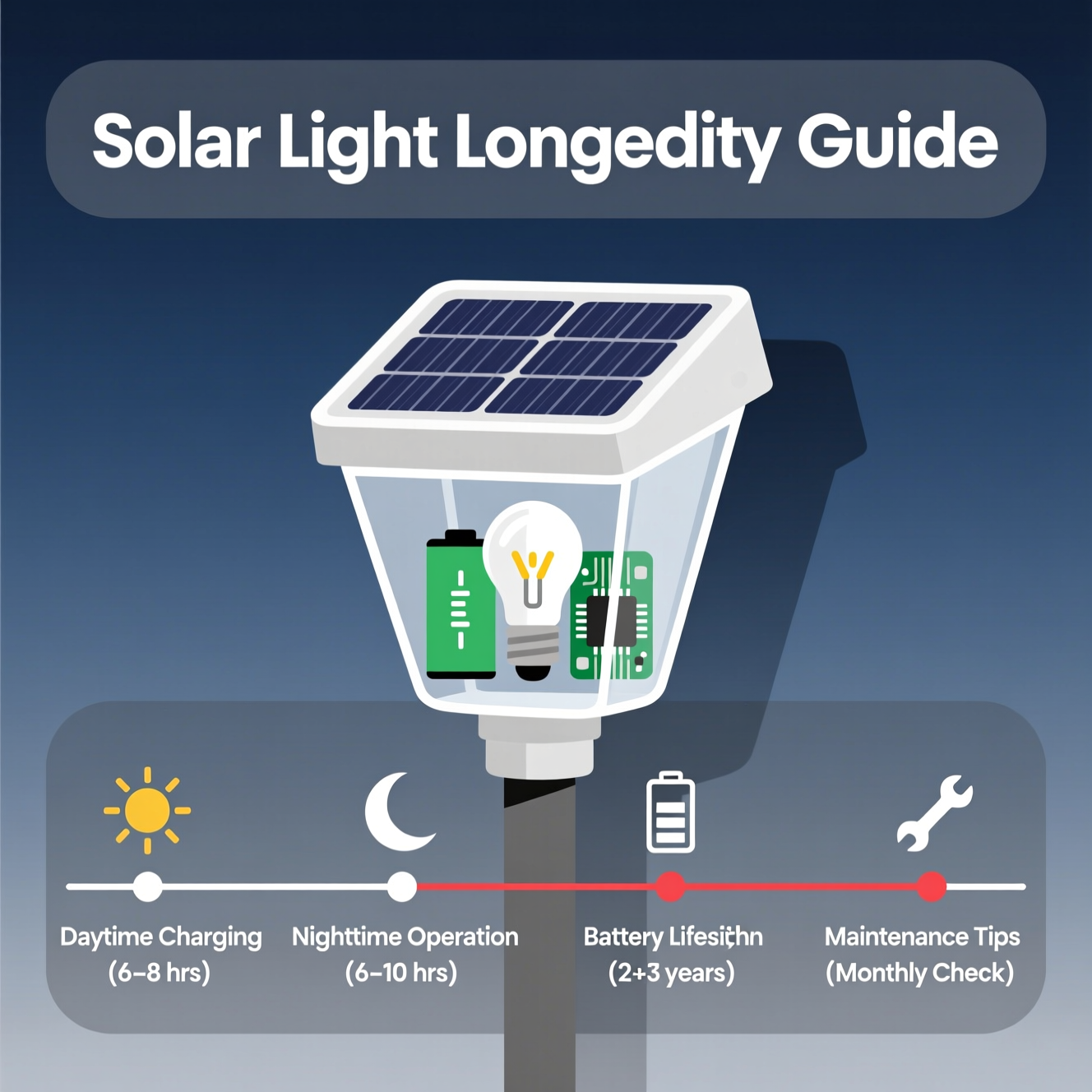What is the Average Lifespan of Solar Garden Lights?
The average solar garden light lifespan typically ranges from 3 to 5 years. High-quality units, featuring durable LED bulbs and robust battery systems, often meet this expectation. The longevity is significantly influenced by the internal battery’s quality and the solar panel’s resilience to environmental wear.
Premium solar lights can maintain over 80% of their original brightness for up to 4 years. The photovoltaic cells convert sunlight efficiently, powering the LEDs. While ambient light sensors regulate their operation, the operational hours are ultimately dependent on battery health and panel performance over time. NiMH batteries are common but degrade with charge cycles.
What Factors Influence the Longevity of Solar Garden Lights?
The durability of solar garden lights hinges on several key factors, primarily related to environmental exposure and component performance. Weather exposure, including rain, wind, and debris, directly impacts the casing and internal workings. Prolonged exposure to direct UV radiation is a significant concern, as it contributes to UV degradation of plastics and seals. Furthermore, corrosion can develop in outdoor conditions, especially in humid or coastal areas.
Internal components like batteries are also critical. Consistent battery cycling, from full charge to depletion, impacts battery health over time. Lights exposed to harsh winters and humid summers may see their lifespan reduced by up to 30% compared to those in temperate climates. Extreme temperature fluctuations and moisture ingress can degrade internal components. For most gardeners, understanding these factors ensures more informed purchasing decisions.
Solar panel efficiency itself plays a role; a panel with better light absorption and less susceptibility to surface damage will perform longer. Maintaining optimal solar panel efficiency is key to the lights’ continued operation. In summary, factors affecting solar light life are multifaceted, encompassing weather exposure, UV degradation, corrosion, battery cycling, and solar panel efficiency, all contributing to overall solar light durability.
How Do Battery Type and Quality Affect Solar Light Lifespan?
The battery type is crucial for solar light lifespan. Common options include Nickel-Cadmium (NiCd), Nickel-Metal Hydride (NiMH), and Lithium-ion batteries. Understanding their characteristics helps in choosing the best battery for solar lights and predicting solar light battery life.
NiMH batteries are prevalent, typically offering 500-1000 charge cycles. Lithium-ion batteries excel with superior energy density, enduring 1000-2000 cycles. Lithium-ion batteries can extend operational life by 2-3 years over standard NiMH batteries. The battery’s re-chargeability is key to its longevity. ‘The lifespan of the battery is often the bottleneck, as it’s the component most affected by repeated charging and discharging,’ states battery specialist Mark Jensen. This highlights why battery replacement solar lights is a common need.
What is the Expected Lifespan of Solar Garden Light Bulbs (LEDs)?
Modern LED solar light bulbs offer exceptional longevity. Unlike older technologies, LEDs are a form of solid-state lighting. This design enhances their durability significantly. Many units are rated for tens of thousands of operational hours, often surpassing the lifespan of the solar light’s battery or housing.
An LED bulb rated for 50,000 hours will last over 15 years if used for 8 hours per night. LEDs don’t typically “burn out.” Instead, they experience gradual light degradation. This process is known as lumen depreciation. Factors like heat dissipation can influence this rate. Proper thermal management ensures optimal performance and extends the useful life of the LEDs, maintaining their color temperature and lumen output.
How Can I Maintain My Solar Garden Lights for Maximum Longevity?
Proper solar garden light care ensures consistent illumination and extends their lifespan. Regular cleaning of solar panels is crucial for optimal light absorption. A buildup of even 1mm of dust can reduce efficiency by 10%. For most gardeners, this debris removal is a simple, effective step.
An annual inspection is recommended to prolong solar light life. Check for and clean any corrosion on battery terminals. Ensure seals remain intact to prevent water damage, which can compromise internal components. Furthermore, cleaning solar panels monthly can increase their energy yield by up to 25% annually, demonstrating a significant performance boost through diligent solar light care tips.
In practical terms, a gentle wipe-down of the entire unit during an annual check can prevent many common failures. This proactive approach to maintain solar garden lights ensures they continue to enhance your outdoor spaces effectively, embodying current best practices for sustainable garden features.
Why Do My Solar Garden Lights Stop Working or Fade Over Time?
Many gardeners experience solar lights not working or solar lights fading. This often stems from common issues like depleted battery charge or a dirty solar panel. If your solar garden lights are not working, internal corrosion can also be a culprit. Troubleshooting solar garden lights requires understanding these potential failure points.
The most common reasons for failure are a degraded battery that can no longer hold a charge, or a dirty/damaged solar panel that fails to collect sufficient sunlight. Up to 40% of solar light failures are attributed to battery degradation after 2-3 years of use. Furthermore, internal circuit board failure due to moisture ingress is also a significant contributor to premature device demise, notes electronics technician Ben Carter. Ensuring adequate sunlight exposure and maintaining clean panels are crucial for sustained performance.
In practical terms, shading from overhanging branches can severely limit the solar panel’s ability to charge the internal battery. Similarly, physical solar panel damage, like cracks or significant scratching, impedes light absorption. Addressing these factors is key to restoring functionality and preventing future issues.
How Long Can Solar Garden Lights Last at Night?
Understanding the runtime of solar garden lights is crucial for consistent nighttime illumination. A fully charged solar light typically offers 6 to 10 hours of light. This duration ensures many models provide illumination from dusk until dawn. The energy storage capacity of the battery is a primary determinant of the illumination duration.
Factors significantly impacting solar light runtime include daily charge optimization and weather conditions. Extensive cloud cover during the day can reduce the total energy stored. Conversely, models with larger battery capacities can offer up to 12 hours of consistent light output. Efficient charge controllers also maximize the energy captured for extended operation.
In practical terms, the unit’s power consumption and the efficiency of its LED components directly influence its nocturnal runtime. For most gardeners, this means a full day’s sun exposure is essential for optimal performance. This ensures reliable, extended periods of light each evening.

Tyler Grant runs our Tools & DIY testing lab, putting pruners, hoses, drip kits, and raised-bed systems through real-garden use. He documents builds, timings, and durability to deliver honest pros/cons and clear recommendations across budgets. Tyler’s guides include safety callouts, maintenance checklists, and step photos you can follow in a weekend.

